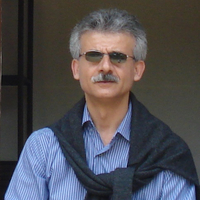Papers by VASILEIOS DEDES

Acta Informatica Medica
Introduction: Patients with plantar fasciitis usually suffer from reduced mobility due to the pai... more Introduction: Patients with plantar fasciitis usually suffer from reduced mobility due to the pain caused by the movement of the tendons involved. Aim: This study was aimed to compare both shockwave and ultrasound therapies in patients with plantar fasciitis by assessing the pain intensity, and both the functionality of the lower limbs and the quality of life impairments. Methods: Total amount of 88 patients with plantar fasciitis constituted the shockwave group, 56 the ultrasound group and 15 the control group. The self-administered questionnaire “University of Peloponnese Pain, Functionality and Quality of Life Questionnaire” was used. The intensity of pain, functionality impairment and quality of life impairment were evaluated on a five-point Likert scale, before treatment, immediately after and at 4-week follow-up. Results: The pain reduction and the improvement of functionality and quality of life after shockwave treatment and ultrasound treatment significantly increased both post-treatment (p<0,001) and at the 4-week follow-up (p<0,001) compared to post-treatment. However, the improvements in the ultrasound group were not as pronounced as in shockwave group (p<0,001). Conclusions: Although both radial shockwave and ultrasound therapies were found to be effective in patients with plantar fasciitis, the statistical analysis showed that radial shockwave is significantly more effective than ultrasound therapy. Keywords: shockwave therapy, ultrasound therapy, rehabilitation, musculoskeletal injuries, plantar fasciitis.

Materia Socio Medica
Introduction: People suffering from tendinopathies exhibit reduced mobility due to the pain cause... more Introduction: People suffering from tendinopathies exhibit reduced mobility due to the pain caused by the movement of the tendons involved. Recently, shockwave therapy has been used as a treatment option, which is non-invasive, simpler, faster and safer. Aims: To record the intensity of the pain, the functionality of the upper and lower limbs and quality of life before treatment with shock waves, immediately after the treatment and the 4-week follow-up. Methodology: The sample consisted of 384 patients, suffering from a tendinopathy. 326 patients constituted the shockwave intervention groups and 58 patients made up the control groups. The researchers created a self-administered questionnaire (University of Peloponnese Pain, Functionality and Quality of Life Questionnaire) in which the intensity of pain, functionality and quality of life were evaluated on a five-point Likert scale, before, immediately after the treatment and at a 4-week follow-up. Results: The pain reduction and the improvement of functionality and quality of life after shockwave treatment increased by at least two points on the fivepoint Likert scale both post-treatment (p<0,001) and at a 4-week follow-up (p<0,001) compared to post-treatment in elbow tendinopathy, Achilles tendinopathy, plantar fasciitis and rotator cuff tendinopathy. Conclusions: Shockwave therapy significantly reduced the pain that accompanies tendinopathies and improves functionality and quality of life. It might be first choice because of its effectiveness and safety.

International Journal of Physical Education, Sports and Health, 2020
The osteoporosis is a progressive disease and the most frequent bone tissue pathological conditio... more The osteoporosis is a progressive disease and the most frequent bone tissue pathological condition. An appropriate diet could help to prevent and manage osteoporosis by assisting in the production and maintenance of bone tissue. The study aimed to compare the impact of nutrition, supplements and drug intake on bone tissue density. The sample of the study consisted of one hundred women between 47 and 94 years old. T and Z score bone density tests were performed before the interventions. People with a T-score of-2.5 and above consisted the drug group and underwent a drug intervention. All others were randomly divided in two groups with a ratio of 1:1. The patients of the nutrition group were instructed by the nutritionist intaking 1200mg of dietary calcium daily and a supplement of vitamin D3 400IU twice daily. The patients of the supplement group had to intake a combined 500mg calcium and 400IU D3 supplement twice daily. T and Z score bone density tests were repeated after 12 months. The results indicated that there were no significant differences between the nutrition and the supplements groups in mean T and Z scores before the intervention. After the treatment, there was a statistically significant increase in mean T and Z scores in both groups, but no significant differences between them. The drugs group had a significant improvement after treatment and significantly better results compared to the other two groups. In conclusion, nutrition intake and calcium-vitamin D supplements significantly reduced the T and Z scores, but with no significant difference between them, in people with osteopenia. In patients with higher initial T and Z scores, the use of drugs is more appropriate for reducing the risk of fractures.

International Journal of Physical Education, Sports and Health, 2020
Introduction: People suffering from Achilles tendinopathy exhibit pain and reduced mobility of th... more Introduction: People suffering from Achilles tendinopathy exhibit pain and reduced mobility of the involved tendon. Pain and limited functionality negatively affect their life quality. Aims: The aim of the present study was to compare the efficiency of radial shockwave therapy and therapeutic ultrasound in improving pain, functionality of lower limbs and life quality in patients suffering from Achilles tendinopathy. Methodology: From the total sample of 130 patients who suffered from Achilles tendinopathy, 65 constituted the shockwave intervention group, 52 the ultrasound group and 13 the control group. A questionnaire was used to evaluate pain intensity, functionality and quality of life at pre-treatment, post-treatment and 4-week follow-up. Results: Pain reduction and improvement in functionality and quality of life after shockwave treatment significantly increased at post-treatment and 4-week follow-up compared to pre-treatment for both shockwave intervention group and therapeutic ultrasound group (p< 0.001). However, the results obtained with the shockwave intervention group were more pronounced than those in the therapeutic ultrasound in all parameters tested both at post-treatment and at 4-week follow-up. Conclusions: Ultrasound therapy was less effective than shockwave therapy in treating Achilles tendinopathy.

International Journal of Physical Education, Sports and Health, 2020
Modern professional soccer is a sport of especially high physiological demands and consequently p... more Modern professional soccer is a sport of especially high physiological demands and consequently physical condition is one of the most crucial and defining factors for succeeding in the sport. The aerobic and anaerobic mechanisms that are employed during a game are extremely demanding and the athlete must be in a position to cope with all kinds of physical strain. The purpose of this study was to investigate the short term and long term physiological adjustments observed in Greek soccer players and to point out the strong and weak points of their physiological profile. In order to examine the long term variation of the physical condition parameters, measurements were taken from a sample of one hundred professional soccer players in four different time periods; before and after preseason, in the middle and at the end of the season. The measurements included the assessment of a) anthropometric characteristics b) cardio respiratory endurance c) anaerobic capacity. The results showed there is statistically significant change (p>.01) in the maximal oxygen uptake capacity (VO2max), the maximal aerobic speed v-VΟ2max, the velocity at the anaerobic threshold, while there was a reduction in the variation of the maximal heart rate-HRmax and an increase in the mean pulmonary ventilation. The mean 10m velocity was reduced by 4%, while regarding the 30m velocity a reduction by 3.5% in average occurred. The ability to maintain mean speed during the Running Anaerobic Speed Test was reduced by 3.0 %. The mean agility speed according to the Illinois Agility Run Test was reduced by 3%. Lastly, the explosive power jumping ability and Squat Jump increased by 8.5%. In conclusion, soccer is a complex sport which poses high demands on all aspects of the athletes' the physical condition. The coaches should be aware of their athletes' training level and the results of the present study could contribute in designing suitable training plans and improving the training process on the whole.
Introduction: People suffering from rotator cuff tendinopathy exhibit reduced mobility due to pai... more Introduction: People suffering from rotator cuff tendinopathy exhibit reduced mobility due to pain. The pain and the limited functionality affect negatively the overall quality of life.
Purpose Patients suffering from lateral epicondylitis exhibit diminished mobility due to pain. Th... more Purpose Patients suffering from lateral epicondylitis exhibit diminished mobility due to pain. The aim of the study was to compare the efficacy of both shockwave and ultrasound therapies in patients with lateral epicondylitis. Methods The shockwave group consisted of 117 patients, 63 patients constituted the ultrasound group, and 18 patients made up the control group. The "University of Peloponnese Pain, Functionality and Quality of Life Questionnaire" was used for the evaluation of pain, functionality, and quality of life on a five-point Likert scale, pre-treatment, post-treatment, and at 4-week follow-up.

Acta Informatica Medica, 2019
Introduction: Patients with plantar fasciitis usually suffer from reduced mobility due to the pai... more Introduction: Patients with plantar fasciitis usually suffer from reduced mobility due to the pain caused by the movement of the tendons involved. Aim: This study was aimed to compare both shockwave and ultrasound therapies in patients with plantar fasciitis by assessing the pain intensity, and both the functionality of the lower limbs and the quality of life impairments. Methods: Total amount of 88 patients with plantar fasciitis constituted the shockwave group, 56 the ultrasound group and 15 the control group. The self-administered questionnaire “University of Peloponnese Pain, Functionality and Quality of Life Questionnaire” was used. The intensity of pain, functionality impairment and quality of life impairment were evaluated on a five-point Likert scale, before treatment, immediately after and at 4-week follow-up. Results: The pain reduction and the improvement of functionality and quality of life after shockwave treatment and ultrasound treatment significantly increased both post-treatment (p<0,001) and at the 4-week follow-up (p<0,001) compared to post-treatment. However, the improvements in the ultrasound group were not as pronounced as in shockwave group (p<0,001). Conclusions: Although both radial shockwave and ultrasound therapies were found to be effective in patients with plantar fasciitis, the statistical analysis showed that radial shockwave is significantly more effective than ultrasound therapy. Keywords: shockwave therapy, ultrasound therapy, rehabilitation, musculoskeletal injuries, plantar fasciitis.

Introduction: People suffering from tendinopathies exhibit reduced mobility due to the pain cause... more Introduction: People suffering from tendinopathies exhibit reduced mobility due to the pain caused by the movement of the tendons involved. Recently, shockwave therapy has been used as a treatment option, which is non-invasive, simpler, faster and safer. Aims: To record the intensity of the pain, the functionality of the upper and lower limbs and quality of life before treatment with shock waves, immediately after the treatment and the 4-week follow-up. Methodology: The sample consisted of 384 patients, suffering from a tendinopathy. 326 patients constituted the shockwave intervention groups and 58 patients made up the control groups. The researchers created a self-administered questionnaire (University of Peloponnese Pain, Functionality and Quality of Life Questionnaire) in which the intensity of pain, functionality and quality of life were evaluated on a five-point Likert scale, before, immediately after the treatment and at a 4-week follow-up. Results: The pain reduction and the improvement of functionality and quality of life after shockwave treatment increased by at least two points on the fivepoint Likert scale both post-treatment (p<0,001) and at a 4-week follow-up (p<0,001) compared to post-treatment in elbow tendinopathy, Achilles tendinopathy, plantar fasciitis and rotator cuff tendinopathy. Conclusions: Shockwave therapy significantly reduced the pain that accompanies tendinopathies and improves functionality and quality of life. It might be first choice because of its effectiveness and safety.











Uploads
Papers by VASILEIOS DEDES